Abstract
1. The mechanism of 5-hydroxytryptamine (5-HT)-induced tachycardia is species-dependent and is mediated directly or indirectly either by '5-HT1-like' (cat), 5-HT2 (rat, dog) or 5-HT3 (rabbit) receptors, or by an action similar to tyramine (guinea-pig). The present investigation is devoted to the analysis of the positive chronotropic effect of 5-HT in the pentobarbitone-anaesthetized pig. 2. Intravenous bolus injections of 5-HT (3, 10 and 30 micrograms kg-1) in pigs resulted in dose-dependent increases in heart rate of 24 +/- 2, 38 +/- 3 and 51 +/- 3 beats min-1, respectively (n = 39). Topical application of a high concentration of 5-HT (150 micrograms kg-1 in 5 ml) on the right atrium was also followed by tachycardia (38 +/- 6 beats min-1, n = 4). 3. A number of drugs which antagonize responses mediated by different 5-HT receptors--phenoxybenzamine, methiothepin, metergoline, methysergide and mesulergine ('5-HT1-like' and 5-HT2 receptors), ketanserin, cyproheptadine, pizotifen and mianserin (5-HT2 receptors), and MDL 72222 and ICS 205-930 (5-HT3 receptors)--did not attenuate the chronotropic responses to 5-HT. 4. The 5-HT-induced tachycardia was also not affected by antagonists at alpha- and beta-adrenoceptors, muscarinic, nicotinic, histamine and dopamine receptors, and calcium channels. 5. Selective inhibitors of 5-HT-uptake, indalpine and fluvoxamine, themselves increased porcine heart rate and facilitated 5-HT-induced tachycardia both in magnitude and in duration.(ABSTRACT TRUNCATED AT 250 WORDS)
Full text
PDF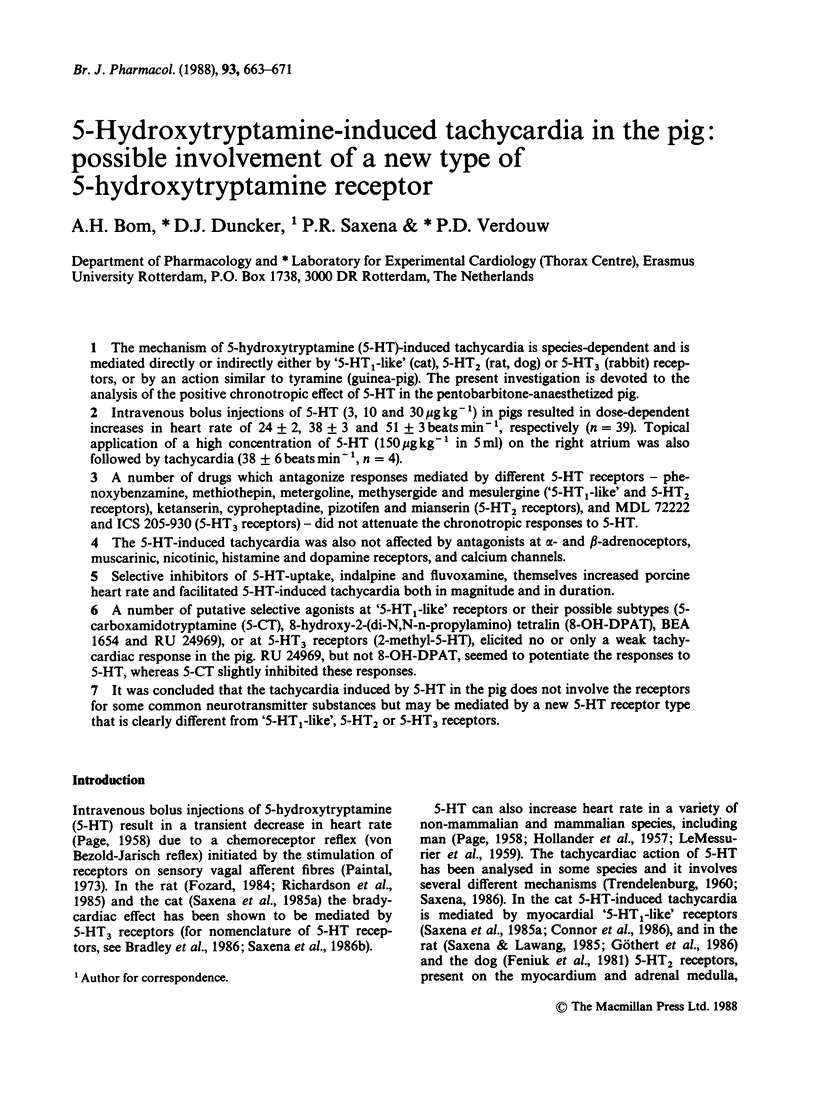
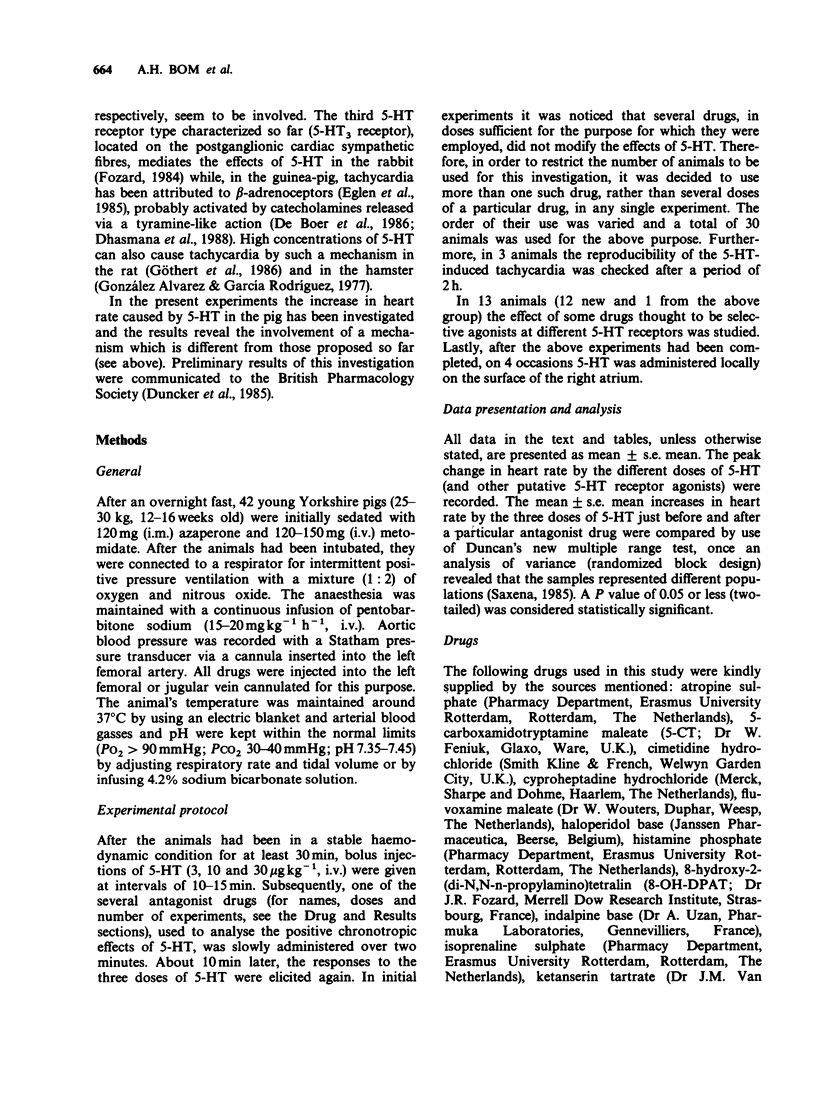
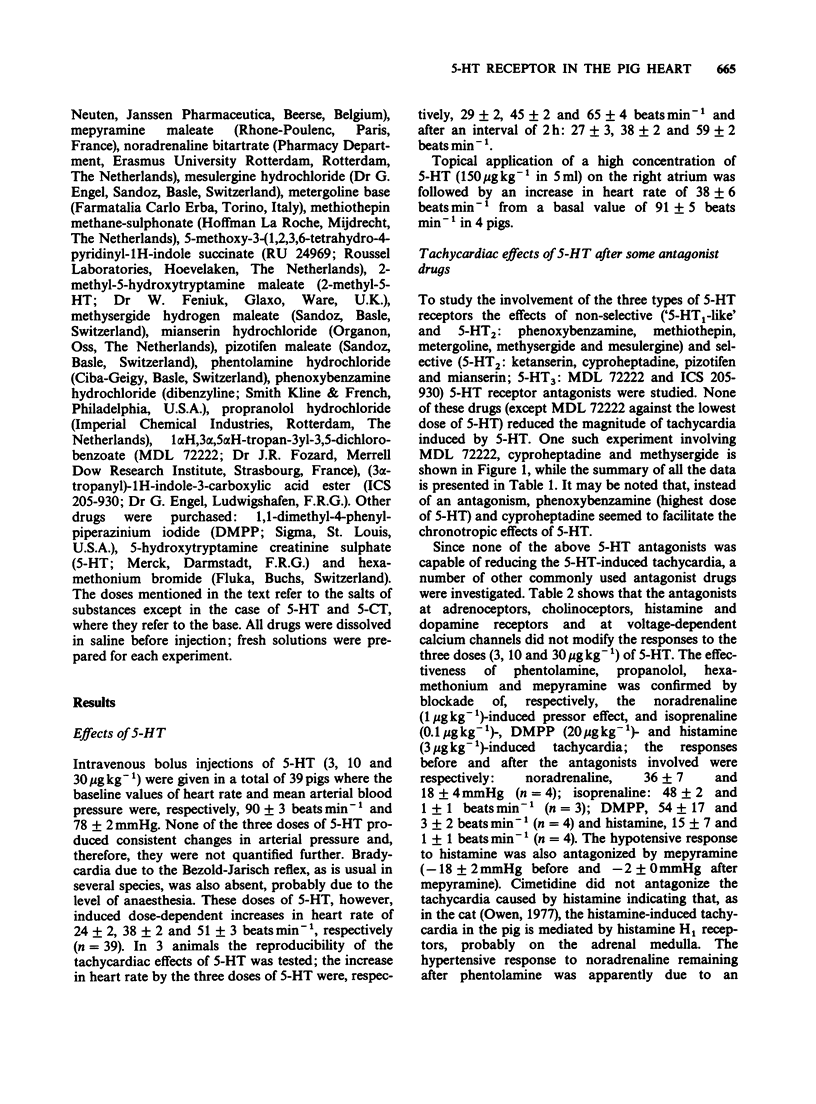
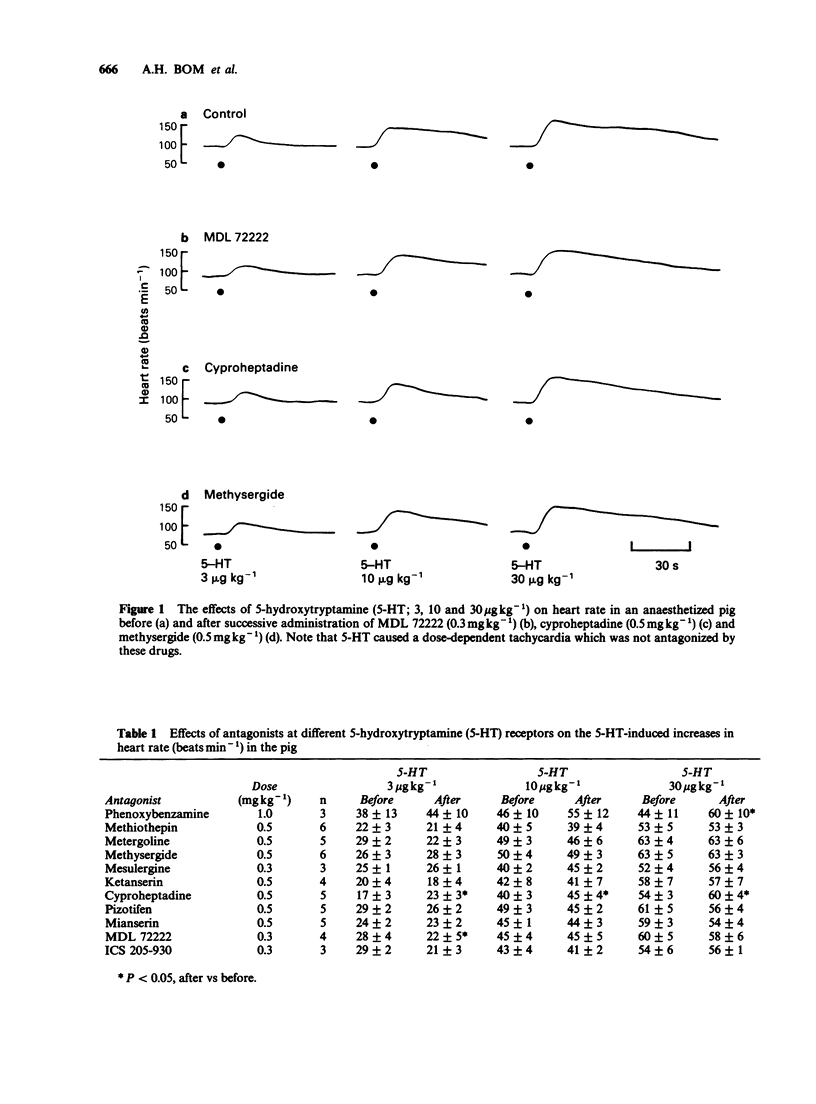
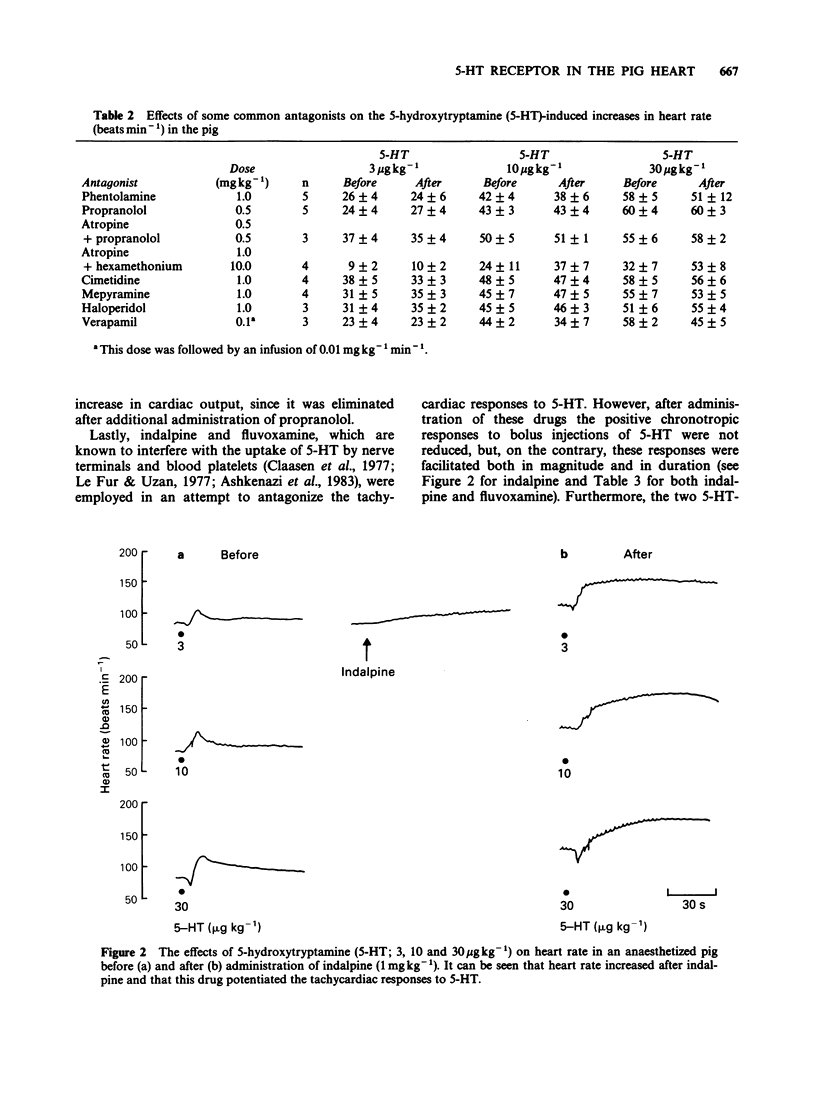
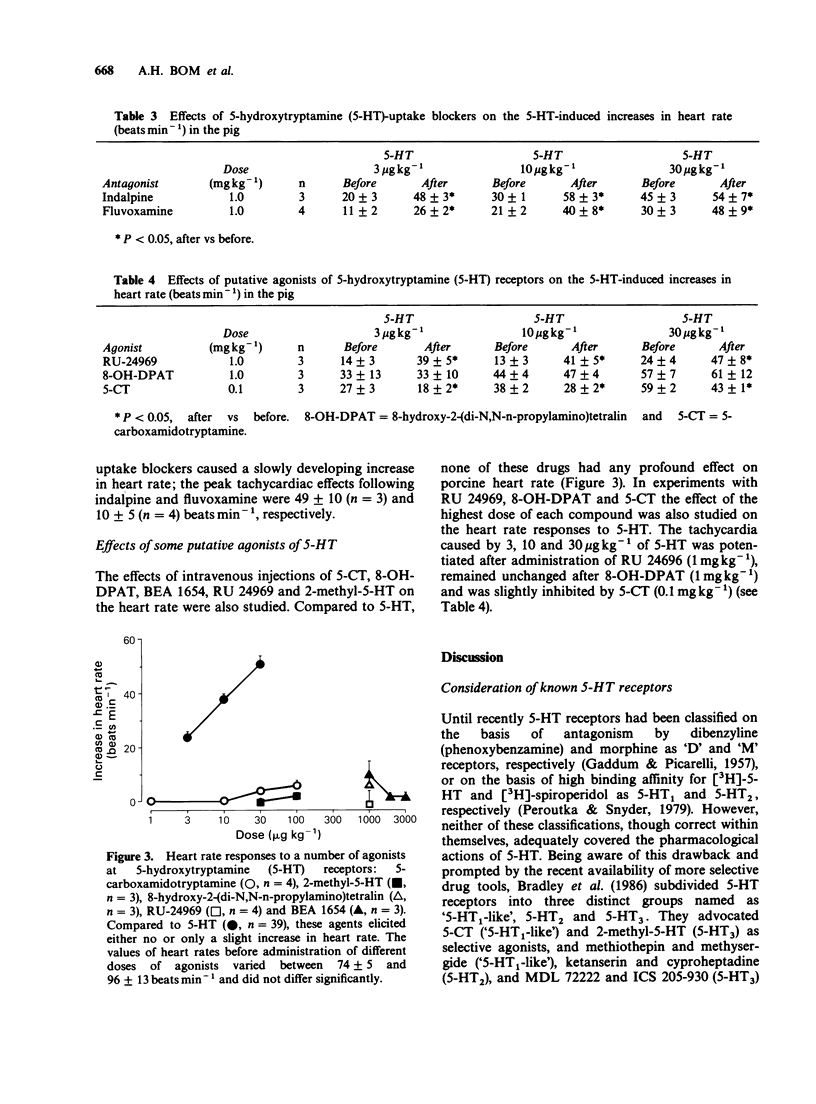
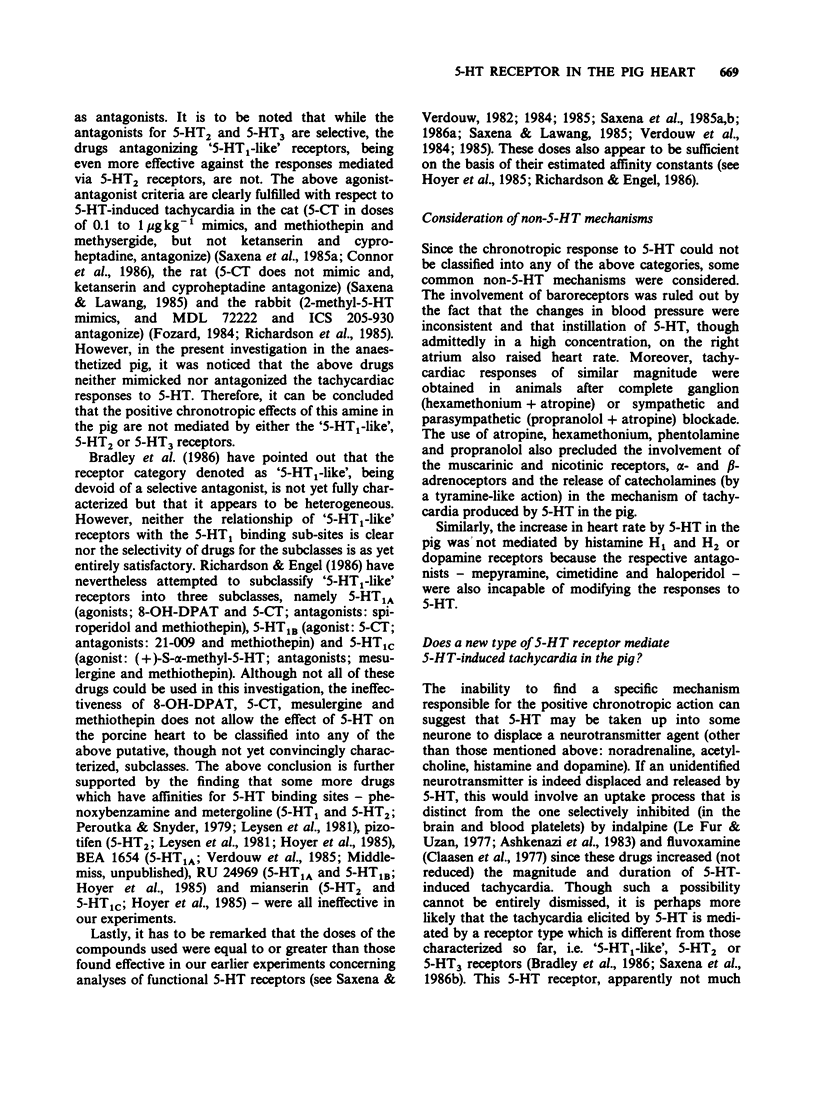
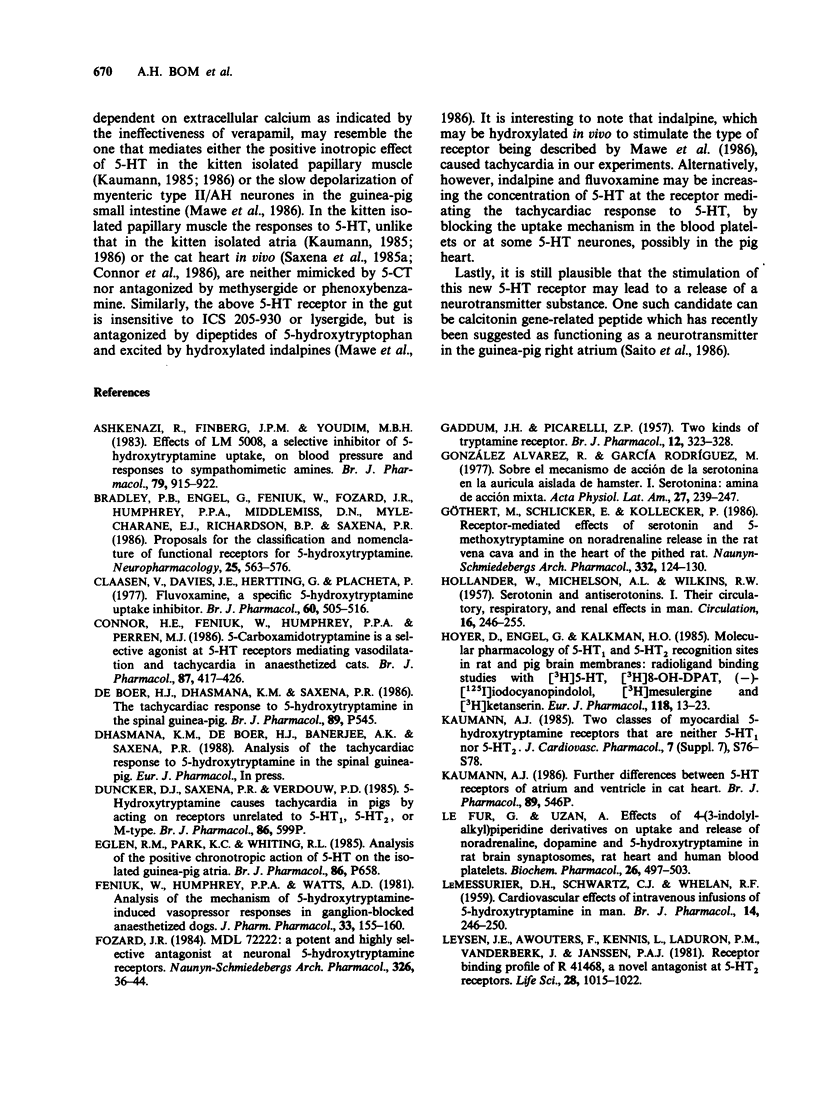
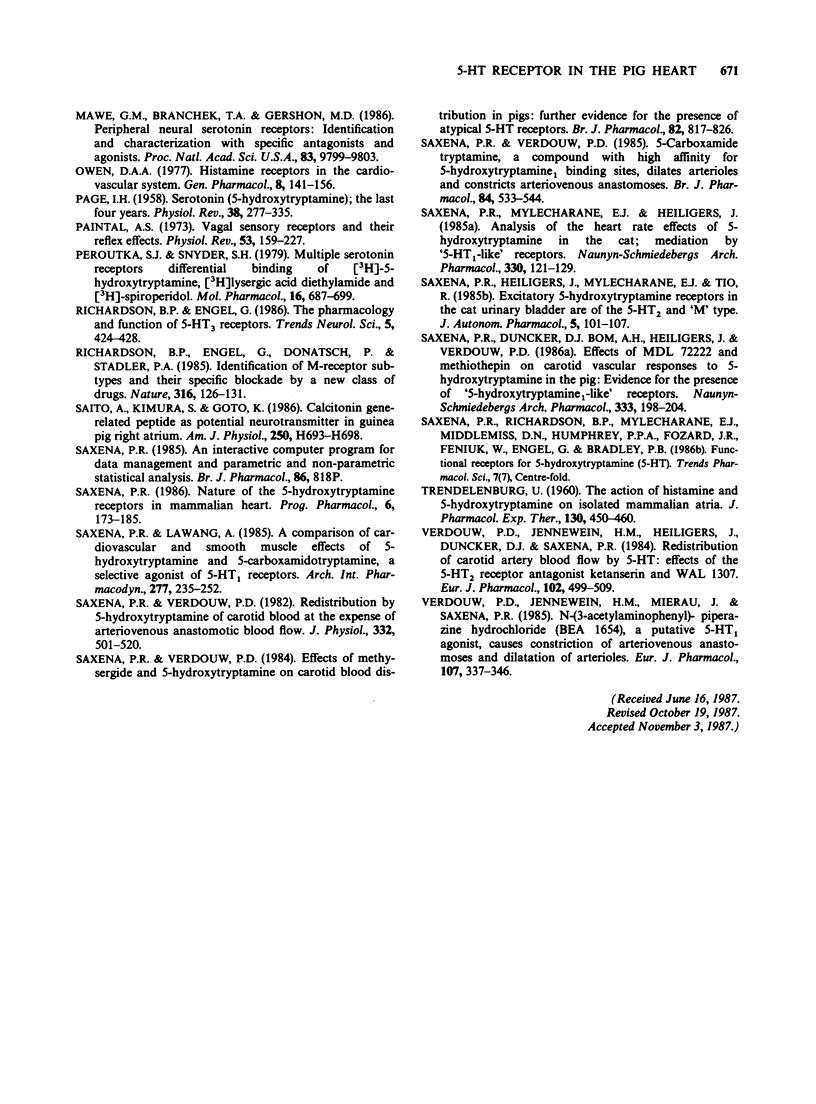
Selected References
These references are in PubMed. This may not be the complete list of references from this article.
- Ashkenazi R., Finberg J. P., Youdim M. B. Effects of LM 5008, a selective inhibitor of 5-hydroxytryptamine uptake, on blood pressure and responses to sympathomimetic amines. Br J Pharmacol. 1983 Aug;79(4):915–922. doi: 10.1111/j.1476-5381.1983.tb10536.x. [DOI] [PMC free article] [PubMed] [Google Scholar]
- Bradley P. B., Engel G., Feniuk W., Fozard J. R., Humphrey P. P., Middlemiss D. N., Mylecharane E. J., Richardson B. P., Saxena P. R. Proposals for the classification and nomenclature of functional receptors for 5-hydroxytryptamine. Neuropharmacology. 1986 Jun;25(6):563–576. doi: 10.1016/0028-3908(86)90207-8. [DOI] [PubMed] [Google Scholar]
- Claassen V., Davies J. E., Hertting G., Placheta P. Fluvoxamine, a specific 5-hydroxytryptamine uptake inhibitor. Br J Pharmacol. 1977 Aug;60(4):505–516. doi: 10.1111/j.1476-5381.1977.tb07528.x. [DOI] [PMC free article] [PubMed] [Google Scholar]
- Connor H. E., Feniuk W., Humphrey P. P., Perren M. J. 5-Carboxamidotryptamine is a selective agonist at 5-hydroxytryptamine receptors mediating vasodilatation and tachycardia in anaesthetized cats. Br J Pharmacol. 1986 Feb;87(2):417–426. doi: 10.1111/j.1476-5381.1986.tb10832.x. [DOI] [PMC free article] [PubMed] [Google Scholar]
- Feniuk W., Hare J., Humphrey P. P. An analysis of the mechanism of 5-hydroxytryptamine-induced vasopressor responses in ganglion-blocked anaesthetized dogs. J Pharm Pharmacol. 1981 Mar;33(3):155–160. doi: 10.1111/j.2042-7158.1981.tb13739.x. [DOI] [PubMed] [Google Scholar]
- Fozard J. R. MDL 72222: a potent and highly selective antagonist at neuronal 5-hydroxytryptamine receptors. Naunyn Schmiedebergs Arch Pharmacol. 1984 May;326(1):36–44. doi: 10.1007/BF00518776. [DOI] [PubMed] [Google Scholar]
- GADDUM J. H., PICARELLI Z. P. Two kinds of tryptamine receptor. Br J Pharmacol Chemother. 1957 Sep;12(3):323–328. doi: 10.1111/j.1476-5381.1957.tb00142.x. [DOI] [PMC free article] [PubMed] [Google Scholar]
- González Alvarez R., García Rodríguez M. Sobre el mecanismo de acción de la serotonina en la auricula aislada de hamster. I. Serotonina: amina de acción mixta. Acta Physiol Lat Am. 1977;27(5):239–247. [PubMed] [Google Scholar]
- Göthert M., Schlicker E., Kollecker P. Receptor-mediated effects of serotonin and 5-methoxytryptamine on noradrenaline release in the rat vena cava and in the heart of the pithed rat. Naunyn Schmiedebergs Arch Pharmacol. 1986 Feb;332(2):124–130. doi: 10.1007/BF00511401. [DOI] [PubMed] [Google Scholar]
- HOLLANDER W., MICHELSON A. L., WILKINS R. W. Serotonin and antiserotonins. I. Their circulatory, respiratory, and renal effects in man. Circulation. 1957 Aug;16(2):246–255. doi: 10.1161/01.cir.16.2.246. [DOI] [PubMed] [Google Scholar]
- Hoyer D., Engel G., Kalkman H. O. Molecular pharmacology of 5-HT1 and 5-HT2 recognition sites in rat and pig brain membranes: radioligand binding studies with [3H]5-HT, [3H]8-OH-DPAT, (-)[125I]iodocyanopindolol, [3H]mesulergine and [3H]ketanserin. Eur J Pharmacol. 1985 Nov 26;118(1-2):13–23. doi: 10.1016/0014-2999(85)90658-2. [DOI] [PubMed] [Google Scholar]
- Kaumann A. J. Two classes of myocardial 5-hydroxytryptamine receptors that are neither 5-HT1 nor 5-HT2. J Cardiovasc Pharmacol. 1985;7 (Suppl 7):S76–S78. doi: 10.1097/00005344-198500077-00022. [DOI] [PubMed] [Google Scholar]
- LEMESSURIER D. H., SCHWARTZ C. J., WHELAN R. F. Cardiovascular effects of intravenous infusions of 5-hydroxytryptamine in man. Br J Pharmacol Chemother. 1959 Jun;14(2):246–250. doi: 10.1111/j.1476-5381.1959.tb01393.x. [DOI] [PMC free article] [PubMed] [Google Scholar]
- Leysen J. E., Awouters F., Kennis L., Laduron P. M., Vandenberk J., Janssen P. A. Receptor binding profile of R 41 468, a novel antagonist at 5-HT2 receptors. Life Sci. 1981 Mar 2;28(9):1015–1022. doi: 10.1016/0024-3205(81)90747-5. [DOI] [PubMed] [Google Scholar]
- Mawe G. M., Branchek T. A., Gershon M. D. Peripheral neural serotonin receptors: identification and characterization with specific antagonists and agonists. Proc Natl Acad Sci U S A. 1986 Dec;83(24):9799–9803. doi: 10.1073/pnas.83.24.9799. [DOI] [PMC free article] [PubMed] [Google Scholar]
- Owen D. A. Histamine receptors in the cardiovascular. Gen Pharmacol. 1977;8(3):141–156. doi: 10.1016/0306-3623(77)90043-x. [DOI] [PubMed] [Google Scholar]
- PAGE I. H. Serotonin (5-hydroxytryptamine); the last four years. Physiol Rev. 1958 Apr;38(2):277–335. doi: 10.1152/physrev.1958.38.2.277. [DOI] [PubMed] [Google Scholar]
- Paintal A. S. Vagal sensory receptors and their reflex effects. Physiol Rev. 1973 Jan;53(1):159–227. doi: 10.1152/physrev.1973.53.1.159. [DOI] [PubMed] [Google Scholar]
- Peroutka S. J., Snyder S. H. Multiple serotonin receptors: differential binding of [3H]5-hydroxytryptamine, [3H]lysergic acid diethylamide and [3H]spiroperidol. Mol Pharmacol. 1979 Nov;16(3):687–699. [PubMed] [Google Scholar]
- Richardson B. P., Engel G., Donatsch P., Stadler P. A. Identification of serotonin M-receptor subtypes and their specific blockade by a new class of drugs. Nature. 1985 Jul 11;316(6024):126–131. doi: 10.1038/316126a0. [DOI] [PubMed] [Google Scholar]
- Saito A., Kimura S., Goto K. Calcitonin gene-related peptide as potential neurotransmitter in guinea pig right atrium. Am J Physiol. 1986 Apr;250(4 Pt 2):H693–H698. doi: 10.1152/ajpheart.1986.250.4.H693. [DOI] [PubMed] [Google Scholar]
- Saxena P. R., Duncker D. J., Bom A. H., Heiligers J., Verdouw P. D. Effects of MDL 72222 and methiothepin on carotid vascular responses to 5-hydroxytryptamine in the pig: evidence for the presence of "5-hydroxytryptamine1-like" receptors. Naunyn Schmiedebergs Arch Pharmacol. 1986 Jul;333(3):198–204. doi: 10.1007/BF00512930. [DOI] [PubMed] [Google Scholar]
- Saxena P. R., Heiligers J., Mylecharane E. J., Tio R. Excitatory 5-hydroxytryptamine receptors in the cat urinary bladder are of the M- and 5-HT2-type. J Auton Pharmacol. 1985 Jun;5(2):101–107. doi: 10.1111/j.1474-8673.1985.tb00110.x. [DOI] [PubMed] [Google Scholar]
- Saxena P. R., Lawang A. A comparison of cardiovascular and smooth muscle effects of 5-hydroxytryptamine and 5-carboxamidotryptamine, a selective agonist of 5-HT1 receptors. Arch Int Pharmacodyn Ther. 1985 Oct;277(2):235–252. [PubMed] [Google Scholar]
- Saxena P. R., Mylecharane E. J., Heiligers J. Analysis of the heart rate effects of 5-hydroxytryptamine in the cat; mediation of tachycardia by 5-HT1-like receptors. Naunyn Schmiedebergs Arch Pharmacol. 1985 Aug;330(2):121–129. doi: 10.1007/BF00499904. [DOI] [PubMed] [Google Scholar]
- Saxena P. R., Verdouw P. D. 5-Carboxamide tryptamine, a compound with high affinity for 5-hydroxytryptamine1 binding sites, dilates arterioles and constricts arteriovenous anastomoses. Br J Pharmacol. 1985 Feb;84(2):533–544. doi: 10.1111/j.1476-5381.1985.tb12938.x. [DOI] [PMC free article] [PubMed] [Google Scholar]
- Saxena P. R., Verdouw P. D. Effects of methysergide and 5-hydroxytryptamine on carotid blood flow distribution in pigs: further evidence for the presence of atypical 5-HT receptors. Br J Pharmacol. 1984 Aug;82(4):817–826. doi: 10.1111/j.1476-5381.1984.tb16478.x. [DOI] [PMC free article] [PubMed] [Google Scholar]
- Saxena P. R., Verdouw P. D. Redistribution by 5-hydroxytryptamine of carotid arterial blood at the expense of arteriovenous anastomotic blood flow. J Physiol. 1982 Nov;332:501–520. doi: 10.1113/jphysiol.1982.sp014427. [DOI] [PMC free article] [PubMed] [Google Scholar]
- TRENDELENBURG U. The action of histamine and 5-hydroxytryptamine on isolated mammalian atria. J Pharmacol Exp Ther. 1960 Dec;130:450–460. [PubMed] [Google Scholar]
- Verdouw P. D., Jennewein H. M., Heiligers J., Duncker D. J., Saxena P. R. Redistribution of carotid artery blood flow by 5-HT: effects of the 5-HT2 receptor antagonists ketanserin and Wal 1307. Eur J Pharmacol. 1984 Jul 20;102(3-4):499–509. doi: 10.1016/0014-2999(84)90571-5. [DOI] [PubMed] [Google Scholar]
- Verdouw P. D., Jennewein H. M., Mierau J., Saxena P. R. N-(3-acetylaminophenyl)piperazine hydrochloride (BEA 1654), a putative 5-HT1 agonist, causes constriction of arteriovenous anastomoses and dilatation of arterioles. Eur J Pharmacol. 1985 Jan 8;107(3):337–346. doi: 10.1016/0014-2999(85)90259-6. [DOI] [PubMed] [Google Scholar]


